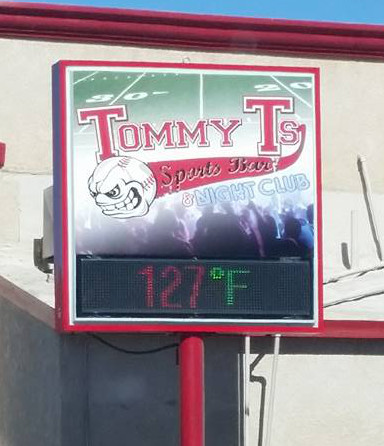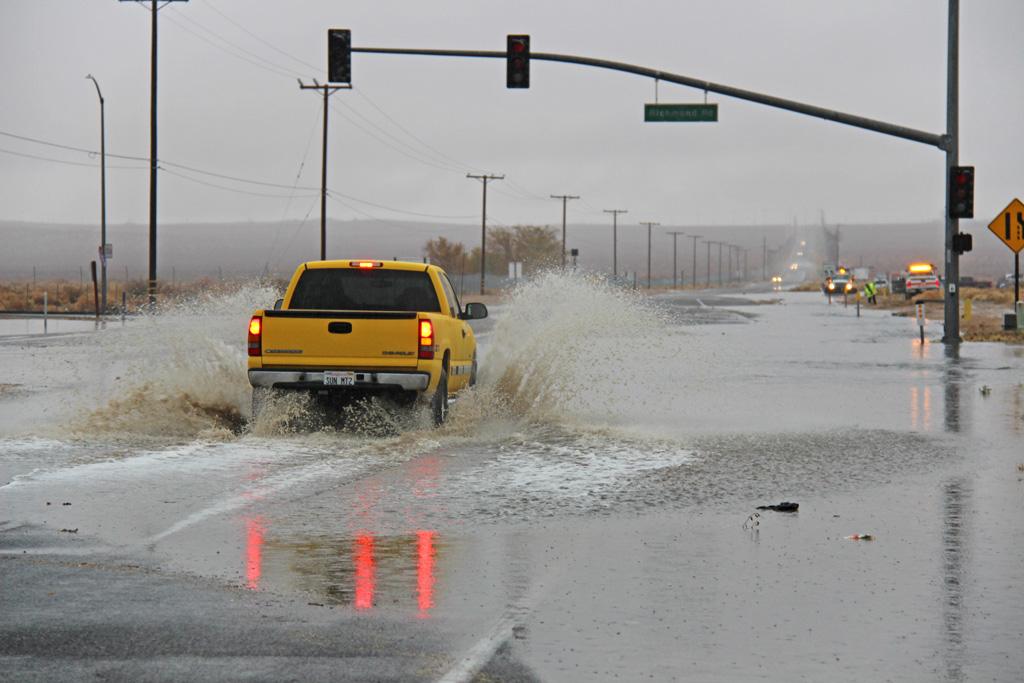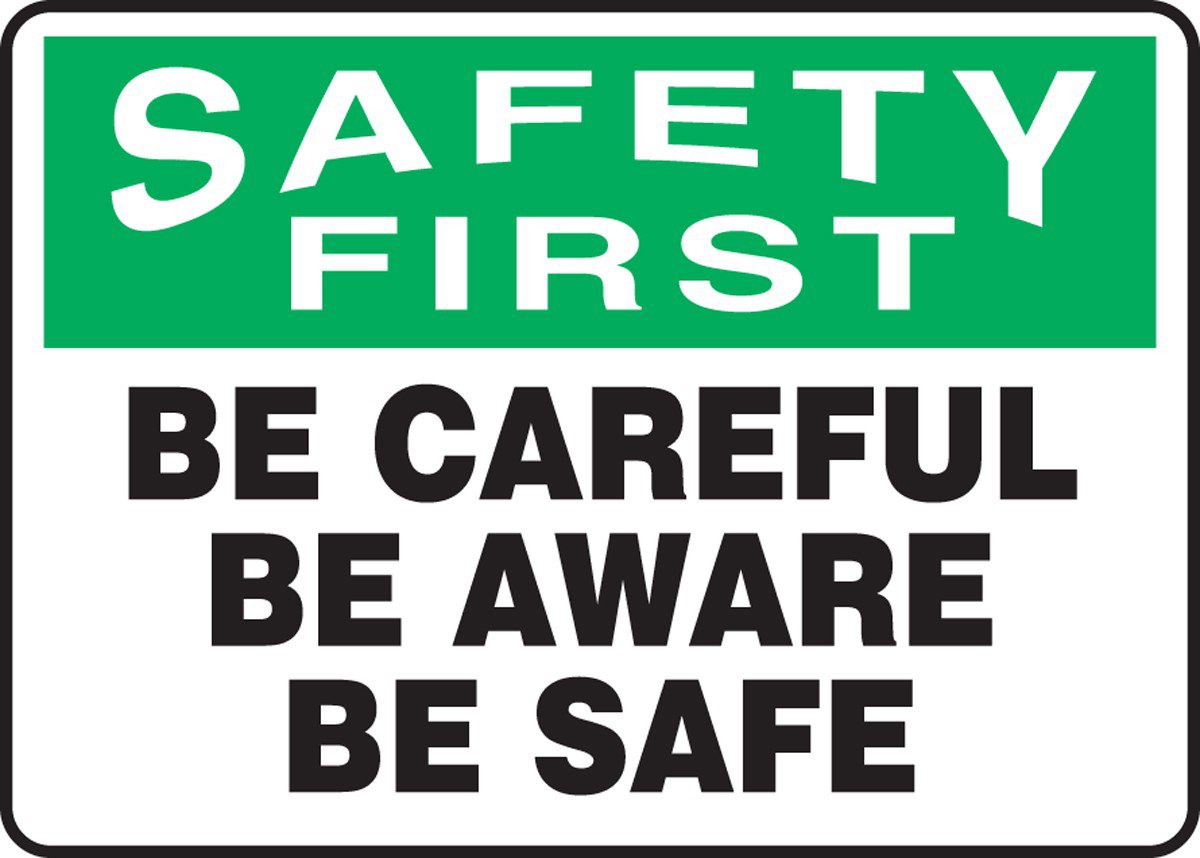Geocaching Locally
Weather Information

The most important thing you need to know, especially when planning on geocaching in the summer is BE PREPARED. With the exception of the summer months, late March through early October we can still see temperatures in the 90's in the afternoon but wake up to temps in the 50's and 60's. We are in between the Mojave Desert and Death Valley and in the summer can rise over 120°
The only way to avoid dehydration is to drink water. Don't rely on your thirst to determine when to drink. Make a habit of drinking water at frequent intervals. Don't ration your water.
One gallon of water or more per person per day is the minimum amount of water you should carry. In hot weather, two gallons or more is strongly recommended. The amount of water someone needs varies from person to person. Remember, it is better to carry too much water, than to run out.
During the warm months, make sure to wear clothing that is light in color and loose fitting. A wide brimmed hat, long sleeved shirt, and long pants will hold perspiration rather than exposing it to the dry desert air. Conserve sweat, not water. In the colder months, dress in layers and always carry a jacket with you.
Ridgecrest is also unusually windy. We joke "Welcome to the Ridgecrest Wind Festival, January 1st - December 31st." While most of the time it's just a gentle breeze, strong hurricane gusts can occur. During the warmer months, the winds usually pick up around late afternoon, early evening and are mild to moderate. During the cooler months, the winds stick around most of the day and can get very strong.
Road Conditions

When it rains, many of the roads are subject to flooding. Even trucks and Jeeps have been caught in floodings. Flash floods do occur. Avoid camping in washes when there is a threat of rain. Do not attempt to cross washes if there is water in them. It is probably deeper and faster than you think.
Two roads that continually flood is Garlock Road (access road between 395 and the 14) and 178 past Trona towards Death Valley. Flooding on the 178 often washes out most of the roads cutting off access. PLEASE verify road conditions before traveling. When in doubt, stay out!
Watch for washouts and keep the speed down as this is a dust control area.
Many roads are accessible year round by any type of vehicle. Within the cities limits they are paved and well traveled. During and after the rains, many of the dirt roads and trails are soft and are better driven with a 4x4. Trails can be iffy on which type of vehicle can be used. For example, the Food Series can be driven by any type of vehicle easily but the Spaded Geo Art is a park and walk for most of it because of the uneven terrain and desert habitat areas. When a description says not a park and grab or please walk, please do so!
Off-highway vehicles (OHVs) provide fun, entertainment, and discovery. However, many of the desert's most attractive and fragile resources can be destroyed if vehicle access is not properly controlled. Resources, cultural and natural, can be unintentionally damaged or destroyed by uncontrolled vehicle use. We all have the responsibility for the proper use of vehicles, so please remember to TREAD LIGHTLY on public and private lands. Stay on designated routes of travel only.
Local Wildlife

Next most important thing is STAY ON MARKED TRAILS! There are many animal habitats in the area including the protected desert tortoise. Irresponsible cachers have in the past driven off marked roads and trails destroying the desert tortoise nesting areas. The desert tortoise is a threatened species and anyone who takes, harass, harm, pursue, hunt, shoot, wound, kill, trap, capture, collect, or attempt to engage in any such conduct is subject to civil and/or criminal penalties of up to a $50,000 fine and one year in jail, or both
We have both venomous (Mojave Green Rattle Snake) and nonvenomous (Chuckwallas) wildlife so please be careful! If bitten or stung by something venomous, call 911 and be prepared to be airlifted to a specialized medical facility as Ridgecrest Regional Hospital may not be able to handle it.
Some of the other common creatures you may see while out geocaching are coyotes, bobcats, desert bighorn sheep, mule deer, wild burros, wild horses, desert hares, ground squirrles, foxes, horned lizards, red-tailed hawks, turkey vultures, quail, bats, roadrunners, sidewiders, rattlesnakes, scorpions, wolf spiders, tarantulas and more!
Watch for wildlife. It is not uncommon for creatures to be guarding caches. DO NOT stick your hands into dark places or into holes and they also like to lie under larger containers such as ammo cans. Many cachers have been injured by feeling around inside places they couldn't see into and disturbing the animals who live there. Walking sticks and retractable mirrors are a desert cachers best friend!
All animals, whether poisonous or not, should be respected. Respect their boundaries by enjoying them from a distance. If you are sleeping outdoors, use a cot. This will keep desert creatures from trying to move in with you at night. Unfortunately, Africanized "killer" bees have established themselves in desert areas of Southern California. If you encounter a large number, swarm, or hive of bees, leave the area immediately.
Desert Hazards

There are many things in our area that are hazardous and not all are seen! Military explosives can be found most anywhere in the desert. Large areas of the desert were and still are used for bombing ranges and maneuvers by the U.S. Armed Forces. There may be unexploded devices that can cause serious bodily injury or death if handled. Report any such devices to the Federal Interagency Communications Center toll free at (888) 233-6518 or call 911.
Both abandoned and active mines exist throughout the deserts of California. Entering mines is dangerous. Poison air and cave ins can and do occur. Several species of wildlife make their homes in mines. Do not enter mines or disturb the wildlife inside.
Cell Phone Service

Many areas such as Trona and Red Rock Canyon have little if any cell service as not all carriers provide coverage in those areas. People have stated they are able to text but not make phone calls. Keep this in mind when traveling and have a backup in case of emergencies. Check with your service provider for coverage, but don't rely strictly on that information.
Due to poor satellite service if you do rely on your cell only for geocaching make sure you download caches for offline use. GPS recievers are much better and people rarely have issues using them while geocaching.
General Safety

Here are some general safety rules to follow while caching in our area.
- Always tell someone your plans, or leave a visible note on the dash of your vehicle with your expected route, destination, and time of return. Stick to your itinerary
- Carry plenty of water. Drink at least a gallon per day.
- Take food or snacks. In the heat, you may not feel hungry, but your body needs nourishment.
- Never go alone.
- Take a good map and compass.
- Carry a first aid kit, signal mirror, flashlight and matches.
- Wear sunscreen and sunglasses
- Dress in light colored, loose fitting clothes. Long-sleeves, long pants, a hat, and sturdy shoes will help protect you from the sun, coarse volcanic material, and sharp, spiny vegetation. Bring a jacket with you, as evening temperatures may drop 30 degrees or more.
- Make sure your vehicle is in good working condition. Check your tires, spare tire, jack, lug wrench, and fluid levels. Always start with a full tank of gas and try not to let it fall below half a tank before filling up again.
- If you are stranded, stay with your vehicle. Don't panic. Your vehicle is easier to spot than a person walking. Lift your hood. Attempt to signal for help using a mirror or by using newspapers to make an X on the ground.
- Watch for snakes, spiders, and scorpions among the rocks.
- And most importantly, HAVE FUN!